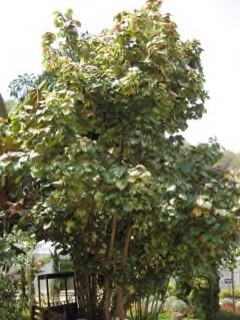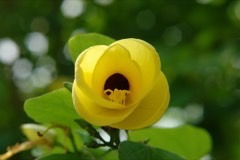 |
|
Raffi Kojian Gardenology.org |
 |
|
Translate this page:
Summary
Suited to coastal environments as it tolerates salinity and waterlogging. Carbon Farming Solutions - Industrial Crop: biomass, fiber. Agroforestry Services: living fence, crop shade, living trellis.
Physical Characteristics

 Hibiscus tilliaceus is an evergreen Tree growing to 8 m (26ft) by 6 m (19ft) at a fast rate.
Hibiscus tilliaceus is an evergreen Tree growing to 8 m (26ft) by 6 m (19ft) at a fast rate.
See above for USDA hardiness. It is hardy to UK zone 8. The flowers are pollinated by Insects.
It is noted for attracting wildlife.
Suitable for: light (sandy) and medium (loamy) soils. Suitable pH: mildly acid, neutral and basic (mildly alkaline) soils and can grow in saline soils.
It cannot grow in the shade. It prefers dry moist or wet soil and can tolerate drought. The plant can tolerate maritime exposure.
UK Hardiness Map
US Hardiness Map
Synonyms
Hibiscus boninensis Nakai. Hibiscus tiliifolius Salisb. Hibiscus circinnatus Willd.Hibiscus porophyllus Vell. Hibiscus tortuosus Roxb. Pariti boninense (Nakai) Nakai. Pariti tiliaceum (L.) A. St.-Hil. Paritium abutiloides (Willd.) G. Don. Paritium tiliaceum (L.) A. Juss.
Plant Habitats
Edible Uses
Edible Parts: Flowers Leaves
Edible Uses:
Young leaves and green bark eaten as a famine food. Leaves are eaten, femented into a sauce, used as a substrate for tempeh starter culture or boiled in salt water to form a beverage called Onge tea [183]. The flowers can be eaten as a potherb or dipped in batter and fried [183].
References More on Edible Uses
Medicinal Uses
Plants For A Future can not take any responsibility for any adverse effects from the use of plants. Always seek advice from a professional before using a plant medicinally.
Flowers have laxative properties.
References More on Medicinal Uses
The Bookshop: Edible Plant Books
Our Latest books on Perennial Plants For Food Forests and Permaculture Gardens in paperback or digital formats.

Edible Tropical Plants
Food Forest Plants for Hotter Conditions: 250+ Plants For Tropical Food Forests & Permaculture Gardens.
More

Edible Temperate Plants
Plants for Your Food Forest: 500 Plants for Temperate Food Forests & Permaculture Gardens.
More

More Books
PFAF have eight books available in paperback and digital formats. Browse the shop for more information.
Shop Now
Other Uses
Design: Seaside; Coastal screening; Shade tree; Coastal street tree; Low maintenance garden, Container growing, Flower garden, Sand stabilization; Xerophytic, Bonsai,. Polynesians have used the wood for outriggers and canoes. Green bark used for dance skirts, strainers for liquids, and for tapa bark cloth. Used for rope and fishing nets. A soft, heavy and porous wood used for fuel and net floats or corks. Living posts with cropping potential for the bark. Hedging. Beach erosion. Coastal rehabilitation. Carbon Farming Solutions - Industrial Crop: biomass, fiber (Crops grown for non-food uses. Industrial crops provide resources in three main categories: materials, chemicals, and energy. Traditional materials include lumber and thatch, paper and cardboard, and textiles) [1-1]. Agroforestry Services: living fence, crop shade, living trellis.
Special Uses
Carbon Farming
References More on Other Uses
Cultivation details
Agroforestry Services: Crop shade Agroforestry Services: Living fence Agroforestry Services: Living trellis Industrial Crop: Biomass Industrial Crop: Fiber Management: Coppice Minor Global Crop
Climate: subtropical to tropical. Humidity: humid. Sea Hibiscus is suited to coastal environments. It tolerates salinity and waterlogging, and can grow in a variety of coastal sands and soils. pH Level: Acid, Neutral, Alkaline. Soil Type: Sandy, Loamy, Sandy loam. Light: Sunny, Light shade. Soil Moisture: Well-drained, Moist soil. Tolerates light frost. Found at elevations from sea level to 800m (2,600ft) in areas that receive 900–2,500mm (35–98in) of annual rainfall. Carbon Farming Solutions - Cultivation: minor global crop. Management: coppice (Describes the non-destructive management systems that are used in cultivation) [1-1].
Carbon Farming
-
Agroforestry Services: Crop shade
Plants providing crop shade especially trees.
-
Agroforestry Services: Living fence
Simply managed rows of shrubs and trees.
-
Agroforestry Services: Living trellis
Plants to physically support other crops.
-
Industrial Crop: Biomass
Three broad categories: bamboos, resprouting woody plants, and giant grasses. uses include: protein, materials (paper, building materials, fibers, biochar etc.), chemicals (biobased chemicals), energy - biofuels
-
Industrial Crop: Fiber
Clothing, rugs, sheets, blankets etc. Currently, almost none of our fiber are produced from perennial crops but could be!
-
Management: Coppice
Cut to the ground repeatedly - resprouting vigorously. Non-destructive management systems maintaining the soil organic carbon.
-
Minor Global Crop
These crops are already grown or traded around the world, but on a smaller scale than the global perennial staple and industrial crops, The annual value of a minor global crop is under $1 billion US. Examples include shea, carob, Brazil nuts and fibers such as ramie and sisal.
References Carbon Farming Information and Carbon Sequestration Information
Temperature Converter
Type a value in the Celsius field to convert the value to Fahrenheit:
Fahrenheit:
The PFAF Bookshop
Plants For A Future have a number of books available in paperback and digital form. Book titles include Edible Plants, Edible Perennials, Edible Trees,Edible Shrubs, Woodland Gardening, and Temperate Food Forest Plants. Our new book is Food Forest Plants For Hotter Conditions (Tropical and Sub-Tropical).
Shop Now
Plant Propagation
Seeds. Large cuttings
Other Names
If available other names are mentioned here
Cotton Tree, Native Rosella
Native Range
Coming Soon
Weed Potential
Right plant wrong place. We are currently updating this section.
Please note that a plant may be invasive in one area but may not in your area so it's worth checking.
None Known
Conservation Status
IUCN Red List of Threatened Plants Status : This taxon has not yet been assessed

| Related Plants
|
| Latin Name | Common Name | Habit | Height | Hardiness | Growth | Soil | Shade | Moisture | Edible | Medicinal | Other |
| Hibiscus acetosella | Cranberry Hibiscus | Annual/Perennial | 1.5 |
9-11
| M | LMH | N | M | 3 | 2 | 3 |
| Hibiscus cannabinus | Kenaf, Brown Indianhemp | Annual/Perennial | 1.8 |
6-12
| F | LMH | N | M | 4 | 2 | 3 |
| Hibiscus diversifolius | Swamp Hibiscus | Shrub | 1.0 |
9-11
| | LMH | N | M | 2 | 1 | |
| Hibiscus heterophyllus | Native Rosella | Shrub | 1.8 |
9-11
| | LMH | N | M | 2 | 0 | 1 |
| Hibiscus moscheutos | Swamp Rose Mallow, Crimsoneyed rosemallow, Wild Cotton, Common Rosemallow, Eastern Rosemallow, Swamp | Perennial | 2.5 |
6-9
| M | LMH | SN | M | 1 | 2 | |
| Hibiscus mutabilis | Cotton Rose, Dixie rosemallow | Shrub | 3.0 |
7-10
| | LMH | N | M | 2 | 2 | 1 |
| Hibiscus radiatus | Monarch Rosemallow. Ruby hibiscus, Clavelina | Shrub | 2.0 |
9-11
| M | LMH | SN | M | 2 | 1 | 2 |
| Hibiscus rosa-sinensis | Chinese Hibiscus, Shoeblackplant, Hawaiian Hibiscus, Tropical Hibiscus, China Rose, Rose-of-China, S | Shrub | 2.5 |
9-11
| F | LMH | N | M | 3 | 3 | 3 |
| Hibiscus sabdariffa | Roselle | Annual/Perennial | 3.0 |
9-12
| F | LMH | N | M | 3 | 3 | 3 |
| Hibiscus sinosyriacus | Rose Of Sharon | Shrub | 3.0 |
6-9
| M | LMH | SN | M | 4 | 2 | 3 |
| Hibiscus syriacus | Rose Of Sharon, Althaea, Shrub Althea, Hardy Hibiscus | Shrub | 3.0 |
5-9
| M | LMH | SN | M | 4 | 2 | 2 |
| Hibiscus trionum | Flower Of An Hour | Annual/Perennial | 0.6 |
9-11
| F | LMH | N | DM | 2 | 1 | 2 |
| Talipariti tiliaceum | Beach Hibiscus, Sea Hibiscus, Cottontree, Mahoe | Tree | 10.0 |
10-12
| F | LMH | N | MWe | 3 | 2 | 4 |
|
Growth: S = slow M = medium F = fast. Soil: L = light (sandy) M = medium H = heavy (clay). pH: A = acid N = neutral B = basic (alkaline). Shade: F = full shade S = semi-shade N = no shade. Moisture: D = dry M = Moist We = wet Wa = water.
Now available:
Food Forest Plants for Mediterranean Conditions
350+ Perennial Plants For Mediterranean and Drier Food Forests and Permaculture Gardens.
[Paperback and eBook]
This is the third in Plants For A Future's series of plant guides for food forests tailored to
specific climate zones. Following volumes on temperate and tropical ecosystems, this book focuses
on species suited to Mediterranean conditions—regions with hot, dry summers and cool, wet winters,
often facing the added challenge of climate change.
Read More
Expert comment
Author
L.
Botanical References
Links / References
For a list of references used on this page please go here
Readers comment
| Add a comment |
|
If you have important information about this plant that may help other users please add a comment or link below. Only comments or links that are felt to be directly relevant to a plant will be included. If you think a comment/link or information contained on this page is inaccurate or misleading we would welcome your feedback at [email protected]. If you have questions about a plant please use the Forum on this website as we do not have the resources to answer questions ourselves.
* Please note: the comments by website users are not necessarily those held by PFAF and may give misleading or inaccurate information.
To leave a comment please Register or login here All comments need to be approved so will not appear immediately.
|
Subject : Hibiscus tilliaceus
|
|
|
|